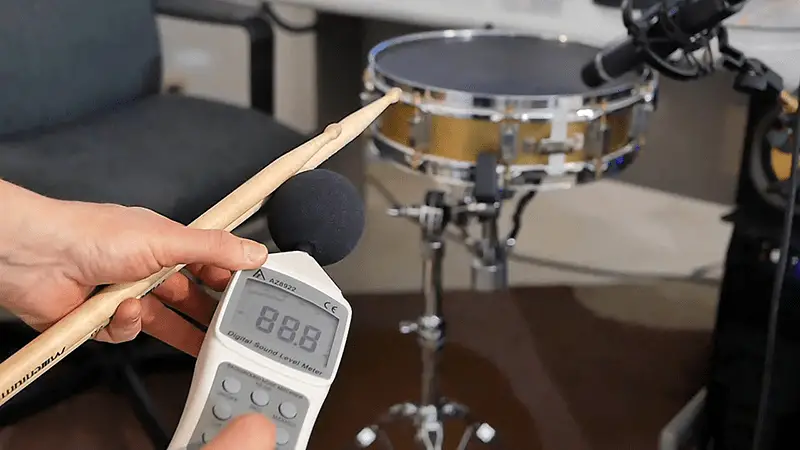
It’s common knowledge that drums are loud, but just how loud are they in relation to other things? As a drummer and and audio engineer, I’ve always been curious and decided to run some experiments to find out.
A drum set and cymbals is 119dB loud on average but can range between 90 and 130dB (decibels) depending on what instruments are being played. Furthermore, the style of music, environment, equipment being used, how hard the drummer is hitting and the distance from the drum set are all factors which can determine how loud drums are perceived to be.
There is a ton of information out there on this topic, most of which can be a bit misleading. Because of this, I’ve compiled and fact checked some existing research and have also completed my own testing, the results of which you’ll find in this article.
…But First, A Primer on the Decibel (dB) and Loudness
Before we can dig into the actual volume measurements of various drums and cymbals, I feel that it is important for us to be on the same page as to what a Decibel is and some of the factors involved in accurately measuring volume, or more accurately sound intensity.
Nerd Warning: This first section is where my audio engineering nerd-ery comes out in full force, so if the specifics of how loudness is measured don’t particularly interest you, feel free to skip to the next section where I outline all of the results and research you.
For those interested in the details, the decibel is a unit of measure for sound intensity (not volume), also called Sound Pressure Level (SPL). The reason why I make the distinction between ‘intensity’ and ‘volume/loudness’ is that not all SPLs are equally loud. Let me explain:
The human ear is more sensitive to certain frequencies than others. More specifically, our ears are more tuned and sensitive to frequencies between 1kHz to 4kHz, which happens to coincide with the sounds related to human speech. (If you’re curious, the total range of human hearing is between 100Hz and 20kHz…give or take a few freqency bands).
By contrast, we are less sensitive to very low and very high frequencies, meaning that these tones must have a higher SPL (or Decibel) measurement in order to be perceived at the same volume as those mid-range frequencies.
Our sense of hearing and (probably by no coincidence) the measurement unit of the decibel are both logarithmic. Without going into great detail here, the big relationship to keep in mind with regards to this article is that in general, for every doubling of distance you can expect the Decibel level to decrease by 6.
In other words, if you are standing 4 feet from a drum kit maintaining a steady 100 dB SPL (I know…unlikely, but stick with me here), if you increased your distance to 8 feet, you can expect the SPL to drop down to 94 dB.
This is why physical distance from loud sound sources is so critical because a matter of a few feet could be the difference between imminent danger and damage to your ears or a mild headache.
Volume measurements of drums and cymbals
Variables: If the above section is any indication, I think I would be doing you a disservice by not mentioning that the variables involved in accurately answering the question of a drum set’s volume are actually pretty wild. Not only do you have drummers (and drums/heads/sticks/cymbals) that vary in volume, you also have factors such as the room you’re in, the device you’re using to measure SPL, how far that device is from the drum set and many other factors which come into play here as well.
That said, all of the following measurements were taken “at the drummer’s ears”, with a few measurements taken at varying distances from the drum set being played. Note:I’m not going to get into the details regarding the brand of drum set used or the heads that were on it, but suffice it to say it was a relatively ‘average’ setup with nothing about it which would significantly impact these general outcomes.
So, let’s start with individual components (all measurements at the drummer’s ears) and then we’ll cover some full drum set measurements:
| Instrument | Decibel Level |
| Bass Drum | 105 dB |
| Toms | 110 dB |
| Snare | 120 dB |
| Snare Rimshot | 125 dB |
| 16″ Crash | 113 dB |
| 14″ Hi Hat (open) | 114 dB |
| 20″ Ride | 101 dB |
| 20″ Ride (bell) | 115 dB |
I think the most obvious results here pertain to a rim shot, which are generally the loudest and most perceived aspect of a drum kit with the bell of a ride cymbal being the runner up.
Now it’s time to put the whole kit together to see what we end up with. For this section, I had the drummer play the same beat, using the majority of the instruments in the kit at varying volumes. I also took measurements at varying distances (at the drummer’s ears, 5 feet and 20 feet) from the drum kit, which helps to illustrate the concept laid out in the Decibels section of this article:
| Volume | At Ears | 5 Feet | 20 Feet |
| Soft | 105 dB | 99 dB | 91 dB |
| Medium | 115 dB | 109 dB | 98 dB |
| Hard Hitter | 125 dB | 120 dB | 111 dB |
| Hard w/ rimshots | 130 dB | 125 dB | 118 dB |
| AVERAGE: | 119 dB | 113 dB | 105 dB |
One thing of interest here is that the results don’t always align perfectly with the rule of a 6dB drop for every doubling of distance. This is largely because of various acoustic factors at play. This experiment was conducted in a relatively small (think living room size) room. This means that there were a lot of sound reflections coming off of various surfaces, which contributed to some higher SPL readings at further distances than we might mathematically expect.
Overall: Based on my experimentation and measurements, the overall average volume of a drum set played at various levels in relatively close proximity is roughly 112 dB.
What sound levels are considered ‘loud’ and dangerous?
There are a couple of specific thresholds of volume in relation to your health which are important to pay attention to:
- 85dB: OSHA (Occupational Safety and Health Administration) requires hearing protection in factories
- 90 dB: Sustained exposure may cause hearing loss
- 120dB: Pain will likely be experienced
- 150dB: Chest wall begins to vibrate
- 160dB: Ear drum ruptures instantly
- 194dB: Loudest possible sound
“15 minutes at the back of a concert hall where the decibel level is 120 dB or greater can cause your hearing to be damaged forever.”
OSHA – Occupational Safety and Health Administration
With an average level of 119 dB at close range, it’s pretty clear hearing protection is nothing to skimp on when it comes to playing drums. I wrote an entire article on hearing loss in drummers and how to avoid it . I would highly recommend reading it if you are concerned about protecting your hearing for the future.
. I would highly recommend reading it if you are concerned about protecting your hearing for the future.
How do drum levels compare to other noisy things?
Drums and percussion instruments generally fall towards the higher end of the volume spectrum, even when played conservatively.
I’ve compiled a list of common-place items and their general sound pressure levels here:
| Breathing | 10 dB |
| Normal conversation | 60-70 dB |
| Telephone dial tone | 80 dB |
| Train whistle at 500 ft. | 90 dB |
| Bass Drum | 105 dB |
| Lawn mower | 107 dB |
| Drum Set Avg at Drummer’s Ears | 119 dB |
| Snare Rim Shot | 125 dB |
| Air Raid Siren | 130 dB |
| Shot Gun | 135 dB |
| Jet engine at 100 ft | 140 dB |
| Loudest sound possible | 194 dB |
For the above chart, I have only included the average measurement of the drum set taken at close range but you can see that while drums are definitely middle of the range in terms of volume, they are well above the level at which hearing protection is strongly recommended.
Reducing the Volume of Your Drums
Playing less aggressively is the most cost-effective method for quickly reducing the overall volume of a drum set. That is not always the easiest or most enjoyable solution. Luckily there are a wide variety of solutions available on the market and typically consist of some sort of dampening material which can be affixed to various instruments.
I’ve written an entire article about different dampening solutions  available to reduce the volume of your drums and cymbals. Please feel free to contact me if you’d like additional tips as well.
available to reduce the volume of your drums and cymbals. Please feel free to contact me if you’d like additional tips as well.
Related Questions:
How loud are drums outside of a house? If no soundproofing efforts have been made to the house, it’s likely that you can expect a 20-30 dB reduction in volume outside of the house, making the average drum set roughly 80-90 dB outside of the house. With carpeting, window insulation and other measures, this number could easily be reduced to the 50-60 dB range.
How many decibels is a cymbal crash? While the answer is dependent on the instrument and they player, a full blown cymbal crash ranges between 110 dB and 125 dB, though the instrument can be played very softly as well.
